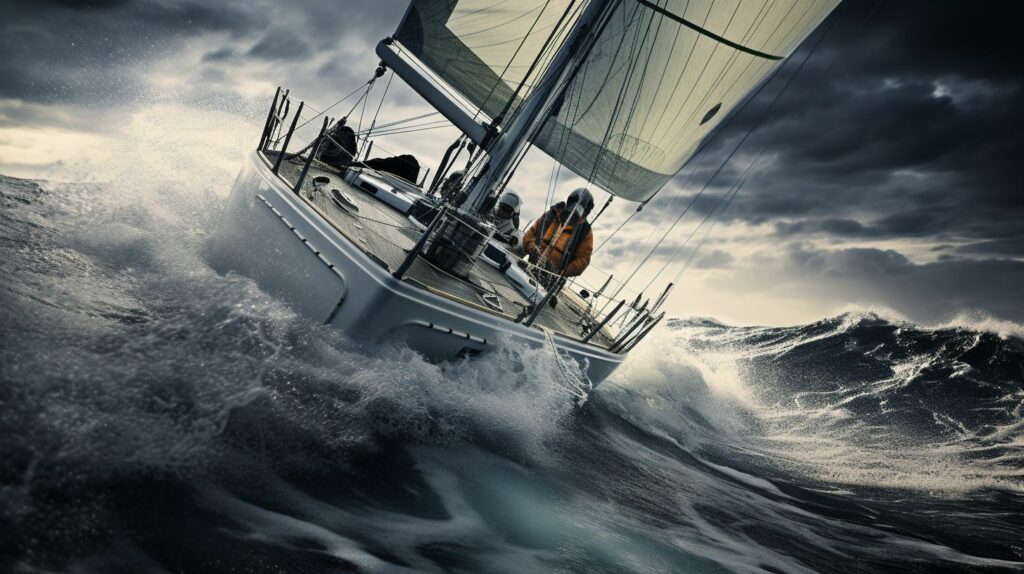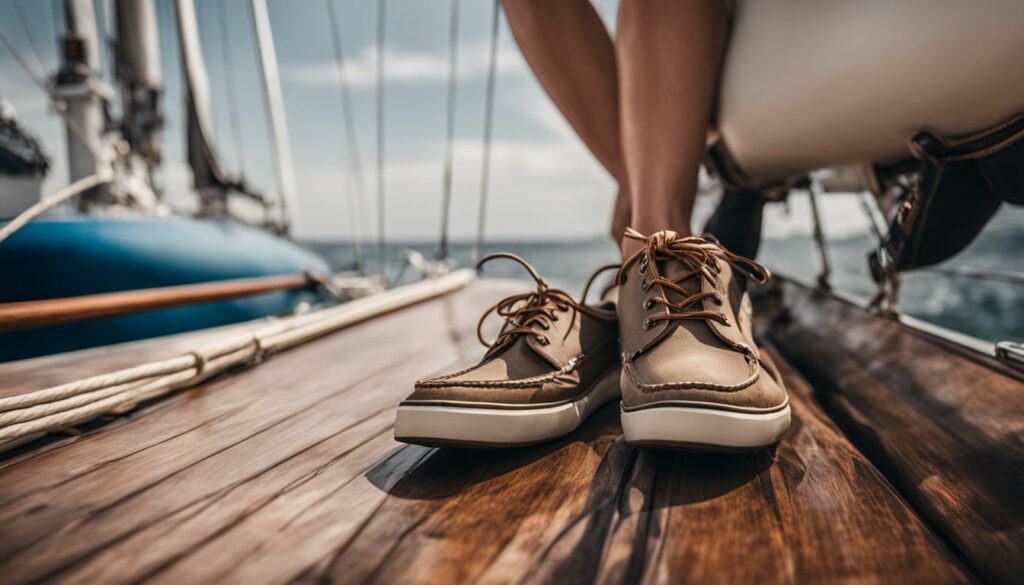Table of Contents
Table of Contents

Ever wondered what do competitive sailors wear to advance their sailing performance? High-quality, functional attire is not just for fashion on deck but plays a pivotal role in bolstering sailors’ competitiveness.
This article is tailored to provide key insight into essential clothing and footwear that competitive sailors trust during races. Let’s set sail towards gaining some sea-worthy style tips!
Key Takeaways
- Competitive sailors dress in special clothing and shoes to stay safe and do their best in races.
- Water-resistant raincoats, trousers, layered clothing, and sailing shirts are essential for keeping dry and warm.
- Sailors choose between boat shoes or deck shoes based on comfort, grip, water resistance, and durability.
- Other important gear includes a sailing jacket for weather protection as well as gloves for improved grip.
Essential Clothing for Competitive Sailing

In competitive sailing, the choice of clothing is vital and has to suit various weather conditions. Impervious to water raincoats keep sailors dry in any weather, while waterproof trousers offer additional protection during races.
A layered clothing system enables easy adaptation to changing temperatures and weather patterns throughout the day. Additionally, a sailing shirt combines comfort and functionality for optimal performance onboard.
Raincoat: A Crucial Item for Any Weather
Every competitive sailor must have a reliable raincoat. Exceptional brands like Gill and Musto offer high-quality raincoats, perfectly designed to withstand oceanic conditions. These essential pieces are crafted from water-repellent materials, ensuring that you stay dry regardless of the weather on your sailing journey.
Not only do they protect from rain showers but also help shield against strong winds, sprays, and splashes during races. Beyond utility, these coats come with features such as breathable fabric for comfort and multiple pockets for convenience.
Therefore, investing in a top-notch raincoat is not just about battling wet weather; it’s an overall comfort enhancer!
Moisture-resistant Trousers: Stay Dry During Races
Rainproof trousers offer significant comfort during races. Brands like Gill provide high-quality, reliable options that keep competitive sailors dry even in the harshest conditions.
These garments, made from water-resistant materials, play a pivotal role in not just keeping you dry but also preventing hypothermia which could impair your performance while out at sea.
In addition to their essential function of being repellent to water, these types of trousers are usually breathable to maintain an optimal body temperature throughout your sailing journey or competition.
Go for a selection with adjustable straps and plenty of pockets– perfect for storing key gear items when required.
Layered Clothing: Adapting to Changing Conditions
Layered clothing plays a crucial role in competitive sailing. Embracing this approach allows for efficient body temperature regulation across different weather conditions. The functionality of wearing multiple layers is heightened when each layer serves a unique purpose.
A base layer, often made from moisture-wicking materials, helps keep the body dry and wards off hypothermia risks by facilitating sweat evaporation. This can be followed up by a mid-layer that provides insulation to retain body heat when it’s cold yet remains breathable during warmer periods.
An outer layer then seals the deal with protection elements against wind and water resistance while maintaining overall breathability for comfort throughout the sailing experience.
Thus, ensuring your layered clothing is lightweight goes a long way to guarantee ease of movement even during tense racing moments or handling complex equipment on deck amidst ever-changing tidal conditions.
Sailing Shirt: Comfort and Function Combined
Sailing shirts are a key piece of gear for any competitive sailor, offering an exceptional balance between comfort and function. By delivering protection against sun, wind, and water while also being easy to move in, these specialized shirts promote safe and efficient sailing.
Many sailors rely on brands such as Gill for their durable designs that withstand the harsh sailing environment authentically. As well as offering solid resistance to wear and tear from elements like salt water and sunlight, good sailing shirts won’t restrict your movement or chafe under safety vests or harnesses when the race gets intense.
Furthermore, they’re designed with quick-drying fabrics so you can stay comfortably dry even after a spray of seawater or sweat!
Proper Footwear for Sailing

Discover the importance of investing in non-slip, water-resistant sailing shoes and explore the pros and cons of boat versus deck shoes. Continue reading to delve into our curated selection of the best footwear for competitive sailing and practical alternatives.
Boat shoes vs. Deck shoes: What’s the Difference?
In the world of competitive sailing, the choice between boat shoes and deck shoes can impact comfort, safety, and performance. Both offer unique features specifically designed for the marine environment, but understanding their differences will help sailors make an informed decision.
| Features | Boat Shoes | Deck Shoes |
|---|---|---|
| Material | Typically made of leather or canvas. | Usually crafted with a rubber sole. |
| Sole Design | Non-marking shoe bottom to avoid scuffing the boat’s deck. | Siped rubber outsole for superior grip on wet surfaces. |
| Water Resistance | Designed to be water-resistant and quick-drying for comfort. | Offers similar water-resistant and quick-drying properties. |
| Durability | Constructed to withstand the rigors of sailing, including bumps and knocks. | Also built to endure the demanding sailing conditions. |
| Protection | Offers protection from water, wind, and sun. | Provides similar levels of protection from the elements. |
| Fit and Comfort | Fit and comfort play a vital role in safety and performance. | Deck shoes also emphasize fit and comfort for optimal performance. |
| Profile | Designed with a low profile to prevent getting caught in rigging or equipment. | Feature a low profile to avoid entanglement with sailing gear. |
| Recommended Brand | Gill is a reliable brand known for durability and performance. | Gill also makes dependable deck shoes that deliver performance and durability. |
Best Boat Shoes for Competitive Sailing
Selecting the right shoes can enhance your performance and ensure safety while sailing competitively.
Alternatives to Sailing Shoes: Pros and Cons
While boat shoes are the traditional go-to for competitive sailing, it’s worthwhile to consider some alternative options. Just like boat shoes, the alternatives each come with their unique set of pros and cons. Here’s a quick summary to help you decide:
| Alternative Footwear | Pros | Cons |
|---|---|---|
| Water sandals | Water sandals are breathable and quick-drying, making them a good choice for warm-weather sailing. They also have non-slip soles, thus providing good traction on wet decks. | Water sandals may not offer the same level of protection as sailing shoes, leaving feet vulnerable to bumps and knocks. They also don’t protect your feet in chilly conditions. |
| Waterproof boots | Water-resistant boots provide excellent protection from water, wind, and cold conditions. They also offer good traction on wet decks as they often have non-slip shoe bases. | They might not be as comfortable as other sailing shoes, especially for prolonged periods. Rainproof boots can also be bulkier and harder to move in than other options. |
| Barefoot | Going barefoot can give sailors a good feel for the boat and the best possible traction. It also eliminates the risk of marking the deck. | Barefoot sailing leaves your feet exposed to potential injury and doesn’t offer any protection from the elements. It’s also not suitable for cold weather sailing. |
| Trainers | Trainers can be comfortable and provide a good grip on the deck. They’re also readily available and can be cheaper than dedicated sailing shoes. | Trainers aren’t typically water-resistant or quick-drying, meaning they may get soggy and uncomfortable in wet conditions. They may also leave marks on the deck. |
Remember, no matter what type of footwear you choose, comfort and safety should be your top priorities!
Additional Sailing Gear: Enhancing Performance and Safety on Deck

This section focuses on additional sailing gear aimed at enhancing performance and safety, covering the crucial role of items like nautical jackets for protection against harsh weather conditions, gloves for improved grip and hand safety, sunglasses to shield from potential glare off the water, and lifejackets or Personal Flotation Devices (PFDs) – key tools in ensuring sailor’s health during competitive events.
Sailing Jacket: Protection from the Elements
Protecting yourself from harsh weather elements involves more than just layering up. A nautical jacket, considered a crucial investment for competitive sailors, plays an integral part in this process.
These jackets are designed with durable and moisture-resistant materials to withstand various weather conditions while maintaining the sailor’s comfort and dexterity.
Offering enhanced performance and safety while sailing, these jackets have become an irreplaceable gear item for sailors. Harsh winds or unpredicted rainfall can occur during a race; here is when your yachting jacket becomes your shield.
Staying dry doesn’t only mean keeping comfortable – it could also be the dividing line between winning or losing a race in extreme situations.
Sailing Gloves: Improved Grip and Protection
Sailing gloves serve dual purposes, offering much-needed grip and critical protection. They form a key part of any competitive sailor’s outfit, catering to the specific requirements of seafaring tasks.
Potential hazards such as rope burn and rough sailing conditions necessitate sturdy handwear. Brands like Gill and Helly Hansen have designed their gloves with ergonomics in mind, resulting in improved grip without sacrificing flexibility or comfort.
Depending on weather conditions and particular tasks at hand, sailors may opt for fingerless models which allow dexterity for actions like knot tying while still protecting palms from friction damage.
Particularly when braving low temperatures, fully covered styles provide additional warmth maintaining performance levels even in demanding environments.
Sunglasses: Guarding Against Glare
Sunglasses serve as an excellent line of defense against glares from the reflective water surface during a sail. They support superior vision and reduce eye strain in bright conditions, enabling sailors to better align with wind currents or steer clear of obstacles.
Top brands like Gill and Nautica offer high-quality eyewear specifically designed for sailing adventures. Sunglasses go beyond mere comfort; they encompass both safety and performance enhancement features, making them an indispensable part of every sailor’s gear selection.
Ensure your chosen pair has polarized lenses that filter out harmful UV rays while providing clear sight under intense light exposure conditions. Brands often develop these sunglasses with wrap-around designs that guard against peripheral glare, enhancing visibility on all sides while offering additional shielding effects from wind or spray.
Lifejackets and PFDs: Essential Safety Gear
Sailing can be unpredictable at times, making lifejackets and personal flotation devices (PFDs) vital equipment for every sailor. They serve as a line of defense in the occurrence of an unexpected fall or other emergencies on the water.
Lifejackets, while slightly bulkier than PFDs are designed to flip an unconscious person onto their back to keep their airway clear. On the other hand, PFDs offer more freedom of movement which is beneficial during competitive sailing but may not turn you over if you’re knocked out cold.
Choosing between a lifejacket and a PFD primarily depends on your particular needs and comfort levels when sailing competitively. For enhanced safety measures, selecting gear certified by trusted standards such as United States Coast Guard approval provides assured quality protection on waters.
What Not to Wear When Sailing Competitively

Discover the unexpected things you should avoid wearing while sailing competitively. Learn more about which colors, fabrics, and common types of clothes may hinder your performance out in the water.
Avoiding Certain Colors and Fabrics
Steering clear of certain colors and fabrics is integral to maximizing comfort and safety during a competitive sailing event. Here’s what you need to consider:
- Dark-colored clothes are usually better options for sailing. They allow the visibility of salt stains less than light-colored ones.
- White clothing, although often associated with sailing, should be avoided due to its tendency to show dirt and other blemishes more readily.
- Jeans are an absolute no-go in the world of sailing. Their ability to retain water can lead to discomfort and hypothermia in cold conditions.
- Prioritize durability and water – resistance when choosing your sailing wardrobe. These elements are crucial for maintaining comfort during long races.
- Despite being comfortable in hot weather, cotton should not be your go-to fabric for sailing events as it retains moisture, leading to chills.
- Similarly, linen may feel good in the heat but does not stand up well against the rigors of competitive sailing.
The Issue with Jeans: Why They’re Not Suitable for Sailing and should not be included in your boat ride outfit
Jeans may come off as a comfortable choice for many activities, but they are not appropriate for yachting. They soak up water like a sponge and become incredibly heavy when wet. This can slow sailors down drastically or even pose risks if one accidentally falls overboard.
The cotton material of jeans is not ideal; it takes forever to dry out compared to other clothing fabrics such as nylon or polyester used in sailing clothing that dries quickly, keeps you warm, and doesn’t restrict your movement.
Further complicating matters, the blue dye commonly used in jeans can bleed onto the boat’s floor when wet causing an unwanted mess!
Preparing for Different Sailing Conditions
Dressing appropriately can make a world of difference when facing different sailing conditions – whether it’s the scorching summer sun or the icy winter winds, we’ve got you covered.
Discover how to prepare your outfit for any weather challenge on our in-depth guide to competitive sailing attire!
Summer Sailing: What to Wear
Preparing for a summer sailing competition involves a careful selection of clothing. For efficient performance, you need to carefully choose what you wear:
- Start with a light and breathable sailing shirt.
- Pair the sailing shirt with quick-drying shorts.
- Always have boat shoes on for safe movement around the vessel.
- To protect your eyes from the sun, always wear sunglasses.
- A hat will shield your face from strong sunlight.
- Slather on plenty of sweat-proof sunscreen before setting sail.
Winter Sailing: Staying Warm and Dry
Competitive sailors understand the importance of specialized clothing for winter sailing that ensures they stay warm and dry.
- Choose high-performance sailing clothes designed specifically for cold and wet weather.
- Opt for a sturdy, water-repellent marine jacket that provides comprehensive protection against wind, rain, and waves.
- Layer your clothing to trap body heat and allow easy removal of pieces if warmer conditions arise.
- Seek out high-quality thermal sailing pants or sailing tops that are windproof, waterproof, and breathable.
- Keep feet warm with good-quality water-resistant quick-drying shoes or boots; durability is vitally important as winter weather can be harsh on footwear.
- Protect your hands from chapping or frostbite with thermal gloves specially designed for sailing.
- Cover your head with a woolen hat or cap lined with micro-fleece to provide both warmth and comfort.
- Invest in UV protective sunglasses that can protect your eyes from glare even in winter when sunlight reflects off snow or icy water.
- Lastly, don’t overlook small details like wearing merino wool socks that provide warmth while also wicking moisture away from the feet.
Packing for a Sailing Competition
Preparing for a sailing competition involves choosing the right gear; from selecting sturdy luggage bags to carry essentials to packing day packs with handy necessities. Even your choice of clothing for when you’re on land – yes, dockside style matters too! Click “read more” to learn about organizing and preparing before setting sail.
Luggage Bags: Carrying Your Gear
Storing your gear while sailing competitively is no small task. The right luggage bag can make all the difference, providing a convenient and space-efficient solution to keeping your clothing and equipment tidy onboard.
Soft rucksacks or holdalls come highly recommended for sailors, fitting seamlessly into sailboat’s compact living areas and cabins. For instance, consider opting for Tortuga travel backpacks made from durable sailcloth.
These water-resistant bags score high on longevity and also bring a certain nautical charm to your sailing attire wardrobe.
Day Packs: Keeping Essentials Handy
Day packs are your reliable on-board assistants in sailing competitions. These compact bags provide a convenient way to keep essentials like sunscreen, snacks, sunglasses, or spare clothes within easy reach.
Watertight versions, such as the stylish Stockholm backpack from Helly Hansen, offer added protection against sudden showers and sea spray.
Top-quality brands like Gill specialize in designing day packs that strike the balance between comfort and practicality. Whether you’re stepping ashore for exploration or carrying groceries back to your boat, these user-friendly accessories serve as trusty companions for a hassle-free sailing experience.
On Land Clothes: Don’t Forget the Dockside
Even the most experienced sailors need appropriate clothing when their feet hit solid land. Dockside attire requires as much consideration as your onboard wardrobe. Look for durable, comfortable shoes that are easy to slip on and off, such as quality flip-flops or sneakers with non-slip soles.
Choose breathable fabrics like cotton or linen for comfort in warm weather, and don’t underestimate the power of a versatile jacket – it can provide warmth during chilly evenings along the coast.
Mindfully pack your dockside gear before setting sail to ensure seamless transitions from sea to shore activities during competitive sailing events.
Conclusion
Competitive sailors know the importance of proper attire, ensuring they stay safe and perform at their highest level. From layered clothing to non-slip footwear, every element has a purpose.
Sailing isn’t just about skill; it’s also about having the right gear for every situation met on the water. The correct choice in sailing wear can make a crucial difference during competitions or even casual sails.
FAQs
1. What type of clothing do competitive sailors wear?
Competitive sailors often opt for sailing clothes that provide full protection like sailing shirts, pants, and other nautical clothing designed from quick-drying fabrics for ultimate comfort.
2. Can you recommend some footwear options appropriate for sailing?
Yes! Options range from casual streetwear shoes like Converse Unisex Chuck Taylor All-Star Low Tops to water sports shoes such as KEEN Men’s SOLR Sandal or Astral Loyak Women’s Water Shoes offering quick dry features. Traditional boat shoes or even high-performance offshore sailing boots can also be an excellent choice.
3. Does the choice of what to wear while sailing depend on weather conditions?
Absolutely! The weather forecast plays a significant role in choosing your boating outfit. For summers, sporty shorts paired with long-sleeve cotton polo shirts work well while winter calls for wet weather gear crafted in GORE-TEX fabric.
4. Are there specific clothes brands popular amongst the sailor community?
Brands like Helly Hansen, Grundèns, Sperry, and Xtratuf are widely trusted by both men and women sailors due to their durability, water-repellent characteristics, and comfortable design suited especially for life at sea.
5. How important is it to choose specialized footwear over bare feet during a regatta?
Wearing suitable water-resistant shoes prevents the risk of stubbed toes while ensuring enhanced hold on wet surfaces thus prioritizing safety at sea over style.
6. On what criteria should one select any sailing outfits?
Selection is based mainly on factors such as functionality providing safeguard against elements, and comfort through quick-dry EVA insoles enabling flexibility towards budget constraints without compromising quality.
7. What are the best sailing-style shoes to wear?
The best sailing shoes are usually deck shoes or boat shoes. They are comfortable to wear, provide good grip on wet surfaces, and have non-marking soles that won’t make marks on the deck.
8. Are wetsuits essential for competitive sailing or dinghy sailing?
Wetsuits are not always essential for all types of competitive sailing, but they are commonly used in colder conditions or when sailing in rough waters. Watersports suits provide insulation and protection against the elements.
9. What other boat shoe options are suitable for sailing?
In addition to sailing shoes, some sailors also prefer to wear good-quality sneakers or sports shoes with non-marking soles. It’s important to choose footwear that is comfortable and provides adequate grip on wet surfaces.
10. Can you recommend any specific brands for sailing attire and yacht clothing?
Several popular brands offer high-quality sailing attire, such as Zhik, Gill, and Sperry. These brands specialize in producing clothing and footwear specifically designed for sailors.
11. What other accessories should competitive sailors have on the boat?
Aside from clothing, competitive sailors should also consider having sailing gloves to protect their hands, as well as sunglasses, hats, and sunscreen to shield themselves from the sun.
12. Do competitive sailors wear sailing gloves?
Yes, competitive sailors often wear sailing gloves to protect their hands from blisters and abrasions. These gloves provide grip and control, especially when handling lines and winches. Look for gloves made from durable, quick-drying materials.
13. What type of deck shoes do competitive sailors put on?
Competitive sailors typically wear boat shoes or sailing shoes. These shoes are designed with non-marking soles to avoid leaving imprints or blemishes on the deck Brands like Sperry and Gill offer comfortable and durable options for sailing footwear.
14. What other sailing apparel do competitive sailors wear onboard?
In addition to jackets and gloves, competitive sailors wear a range of sailing apparel. This may include sailing pants, technical shirts, wetsuits, and life jackets. It is important to choose clothing that is comfortable, lightweight and provides protection against the elements.
15. What should I know about footwear for sailing?
When it comes to footwear for sailing, it is crucial to choose a pair of sailing shoes that are comfortable to wear and provide good traction on wet surfaces. Look for shoes that are specifically designed for sailing and offer features like a non-marking sole and quick-drying material.
16. What should I wear for dinghy sailing?
For dinghy sailing, it is important to wear clothing that allows for ease of movement. This may include a wetsuit or a combination of lightweight layers such as rash guards and quick-drying shorts or pants. Don’t forget to wear appropriate footwear.
17. What do competitive sailors wear during a regatta?
During a regatta, competitive sailors typically wear their team uniforms or matching apparel to represent their sailing club or team. This may include branded technical clothing such as shirts, jackets, and hats.
18. Do sailing gloves leave marks on the deck?
No, sailing gloves are designed with non-marking materials to avoid leaving any marks on the deck

